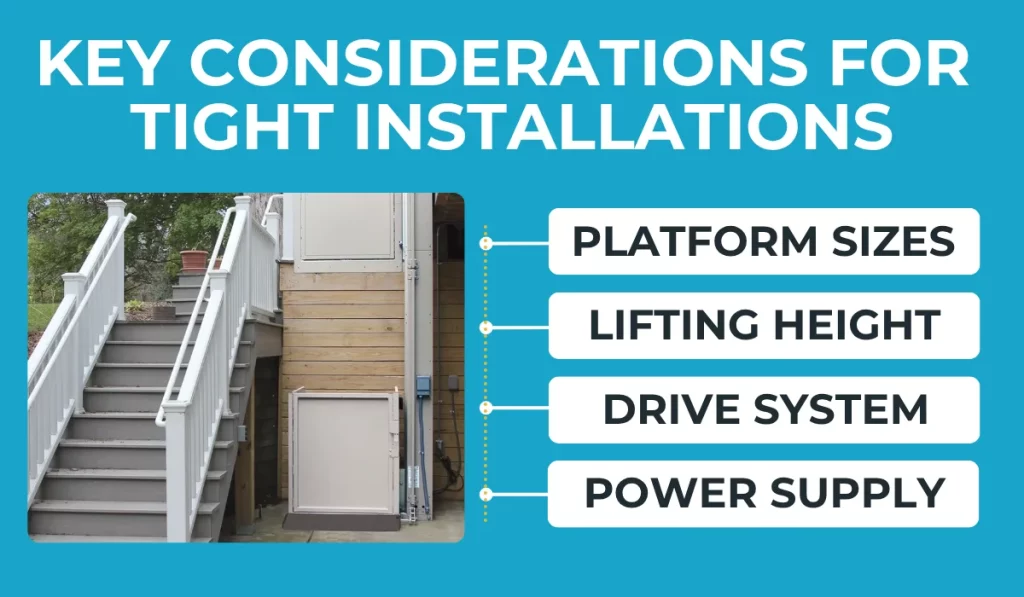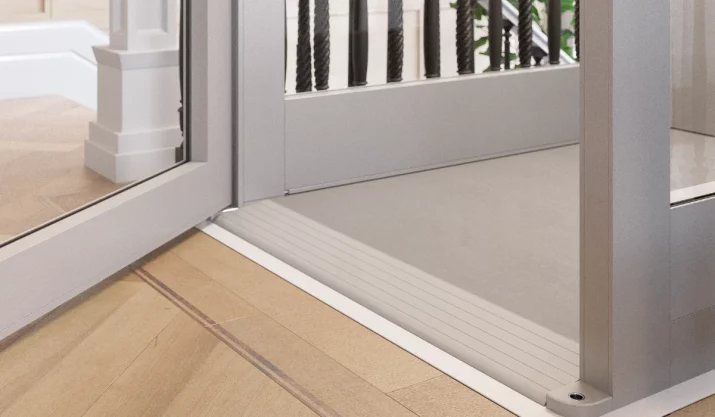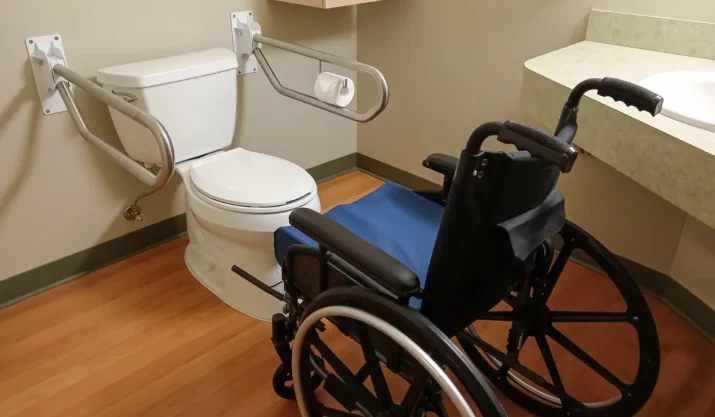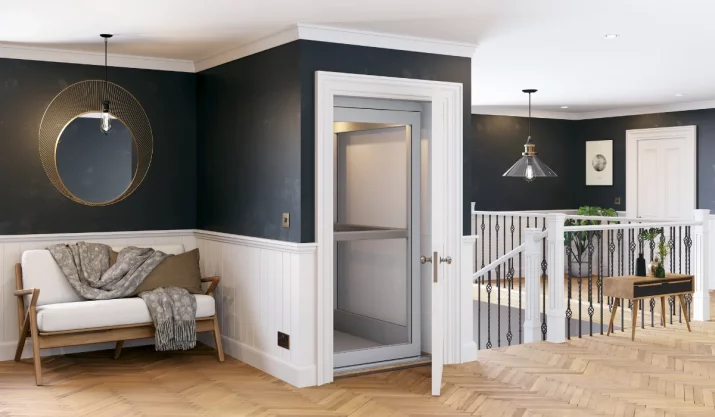Installing a Vertical Platform Lift in Tight Spaces

Table of Contents
- Key Takeaways
- What is a Vertical Platform Lift?
- Can You Install a Vertical Platform Lift in a Small Space?
- Key Considerations for Tight Installations
- Choosing the Right Lift for Small Spaces
- Common Features That Matter
- Bruno Vertical Platform Lifts: A Trusted Option
- Indoor vs. Outdoor Lift Installation
- Vertical Platform Lift vs. Stair Lift vs. Inclined Platform Lift
- Cost Considerations
- A Local Solution for Tight-Space Accessibility
- FAQs
If you’re trying to make your home more accessible but don’t have a lot of extra room, you’re not alone. Many California homes, especially older ones, simply weren’t designed with accessibility in mind.
But that doesn’t mean you have to move or give up your independence. You can install a vertical platform lift (VPL) as a practical solution for small spaces, especially if you’re a wheelchair user, use a power chair, or rely on a scooter.
In this article, we’ll walk you through the process of installing a vertical platform lift in small spaces, outline the key considerations, and provide a comprehensive comparison of lift options to help you make the best choice for your needs.
Key Takeaways
- Vertical platform lifts offer space-saving access for wheelchair and scooter users without major renovations.
- Models like Bruno’s are built with small footprints, safety features, and ADA compliance in mind.
- Indoor and outdoor options are available, including porch lifts and shaftway installations.
- Planning for platform size, lifting height, and drive system is essential in tight-space installations.
What is a Vertical Platform Lift?
Navigating a two-story home can be especially challenging for wheelchair users, and not every home has the space to accommodate a wheelchair ramp. Vertical platform lifts (VPLs), also known as wheelchair lifts, provide accessibility solutions for homeowners and their loved ones with mobility challenges, requiring a minimal footprint.
VPLs function like a compact elevator with a high lifting capacity, designed to lift a person and their mobility device through short vertical distances, such as between ground level and a porch, deck, or raised entryway.
Unlike stair lifts, which carry a seated person along a stair rail, a VPL moves vertically along a track, making it better for users who cannot easily transfer in or out of their wheelchair or scooter.
Can You Install a Vertical Platform Lift in a Small Space?
Yes, you can, and it’s more common than you might think. Vertical platform lifts are designed with flexibility in mind. Whether you have a narrow side yard, a small garage, or limited space inside your home, manufacturers offer space-saving and space-efficient models to fit tight footprints.
Key Considerations for Tight Installations

While wheelchair lifts offer convenience, they are not all the same. Here are some key considerations you can look into while planning to install a VPL in a tight area:
1. Platform sizes
The most crucial factor to consider when choosing a VPL is the platform size. Ensure it fits your mobility device comfortably and provides sufficient space for safe and easy maneuvering. Some lifts offer platforms as compact as 34” x 48”. While compact, this platform size can still accommodate most wheelchairs and scooters.
2. Lifting height
Determine the vertical distance the lift needs to cover. Most standard VPLs can handle heights between 4 and 14 feet, but custom models are available for greater elevations. Getting this measurement right is crucial, not only to ensure that the lift reaches your desired level but also to prevent costly modifications, delays, or safety issues during installation.
3. Drive system
VPLs may come with different drive systems, with screw-driven and hydraulic systems being the most common. Screw-driven lifts are popular for small spaces because they don’t require a separate machine room or a large pit.
4. Power supply
Most residential lifts use standard 110V power. However, some are battery-powered, allowing continued use during power outages.
Choosing the Right Lift for Small Spaces
Selecting the right model is essential when working with limited space. At California Mobility, we often recommend unenclosed vertical platform lifts for tight outdoor applications, such as a porch lift beside a front stoop. For indoor use, we recommend shaftway installations as these make better use of vertical space.
Common Features That Matter
- Constant pressure controls: Ensure a steady and safe ride for the user.
- Emergency stop button: This safety feature helps users prevent further damage to the lift or safety risks in case of a malfunction.
- Remote controls: This feature enables caregivers to operate the lift while assisting the user easily.
- Weight capacity: Most lifts have a high lifting capacity, supporting between 600–750 lbs., which covers most power chairs, scooters, and users.
- Weather-resistant construction: Residential outdoor lifts are typically constructed with durable, weather-resistant components that can withstand California’s varied climate. This feature is essential for coastal homes, where salty air can increase the risk of rust and corrosion.
Bruno Vertical Platform Lifts: A Trusted Option
Bruno is one of the most trusted brands we at California Mobility install in homes. Known for its durable, American-made accessibility solutions, Bruno’s VPLs are specifically built to perform well in compact residential environments. Residential lifts from Bruno’s offer:
- Compact footprints
- Indoor and outdoor configurations
- ADA-compliant features
- Simple, clean installations
Bruno’s safety features and customizable options also make them an excellent fit for commercial and public buildings.
Indoor vs. Outdoor Lift Installation
Plan carefully whether you’re installing your lift beside a deck or in a garage.
Outdoor installation
- Ideal for front steps, decks, or rear entrances.
- Requires a weather-resistant model.
- Often installed as a porch lift.
Indoor installation
- Works well for split-level homes or garages.
- May require shaftway framing or minor construction.
- It can be less visible than outdoor options.
In either case, a professional lift installation team will ensure that your site is prepared correctly and meets local California building codes.
Vertical Platform Lift vs. Stair Lift vs. Inclined Platform Lift
If you’re deciding between different lift solutions, here’s a table to help you compare your options:
| Feature | Vertical Platform Lift | Stair Lift | Inclined Platform Lift |
|---|---|---|---|
| Best for | Wheelchair users, scooters | Users who can transfer to a seat | Wheelchair users with straight stairs |
| Space use | Requires footprint at top & bottom | Minimal footprint on stairs | Follows the stair angle |
| Transfer needed | No | Yes | No |
| Common in | Indoor/outdoor, residential & commercial | Primarily indoor residential | Commercial or large stairways |
Cost Considerations
Vertical Platform Lifts aren’t cheap, but they are a wise investment. These lifts offer a cost-effective way to enhance your home’s accessibility without requiring major renovations or relocation.
The total cost of installing a VPL in your home can vary based on factors such as lifting height, platform size, customization, and whether the lift is enclosed.
If you have financial limitations but need to make your home more accessible, help is available. In California, several local programs and grants offer support specifically for accessibility upgrades.
A Local Solution for Tight-Space Accessibility
Making your home more accessible by installing a VPL can be costly. However, you can’t put a price on safety, convenience, and independence. Making your home more accessible doesn’t always require a significant remodel. Whether you’re in San Diego, Sacramento, or anywhere in between, a well-planned vertical platform lift provides a space-saving alternative that complements the home you already love.
At California Mobility, we’re happy to help you determine which wheelchair lift best meets your needs.
Contact us today for a free quote or call us at our phone number for a faster response. We’ll be happy to discuss your options and even explain our service, repair, and warranty policies for the different mobility models we offer.






